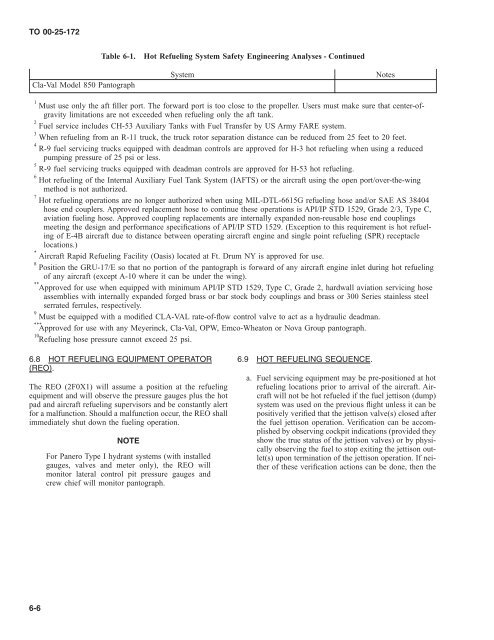TO 00-25-172 - Robins Air Force Base
TO 00-25-172 - Robins Air Force Base
TO 00-25-172 - Robins Air Force Base
You also want an ePaper? Increase the reach of your titles
YUMPU automatically turns print PDFs into web optimized ePapers that Google loves.
<strong>TO</strong> <strong>00</strong>-<strong>25</strong>-<strong>172</strong><br />
Table 6-1.<br />
Cla-Val Model 850 Pantograph<br />
Hot Refueling System Safety Engineering Analyses - Continued<br />
System<br />
Notes<br />
1<br />
Must use only the aft filler port. The forward port is too close to the propeller. Users must make sure that center-ofgravity<br />
limitations are not exceeded when refueling only the aft tank.<br />
2<br />
Fuel service includes CH-53 Auxiliary Tanks with Fuel Transfer by US Army FARE system.<br />
3<br />
When refueling from an R-11 truck, the truck rotor separation distance can be reduced from <strong>25</strong> feet to 20 feet.<br />
4<br />
R-9 fuel servicing trucks equipped with deadman controls are approved for H-3 hot refueling when using a reduced<br />
pumping pressure of <strong>25</strong> psi or less.<br />
5<br />
R-9 fuel servicing trucks equipped with deadman controls are approved for H-53 hot refueling.<br />
6<br />
Hot refueling of the Internal Auxiliary Fuel Tank System (IAFTS) or the aircraft using the open port/over-the-wing<br />
method is not authorized.<br />
7<br />
Hot refueling operations are no longer authorized when using MIL-DTL-6615G refueling hose and/or SAE AS 38404<br />
hose end couplers. Approved replacement hose to continue these operations is API/IP STD 1529, Grade 2/3, Type C,<br />
aviation fueling hose. Approved coupling replacements are internally expanded non-reusable hose end couplings<br />
meeting the design and performance specifications of API/IP STD 1529. (Exception to this requirement is hot refueling<br />
of E-4B aircraft due to distance between operating aircraft engine and single point refueling (SPR) receptacle<br />
locations.)<br />
*<br />
<strong>Air</strong>craft Rapid Refueling Facility (Oasis) located at Ft. Drum NY is approved for use.<br />
8<br />
Position the GRU-17/E so that no portion of the pantograph is forward of any aircraft engine inlet during hot refueling<br />
of any aircraft (except A-10 where it can be under the wing).<br />
**<br />
Approved for use when equipped with minimum API/IP STD 1529, Type C, Grade 2, hardwall aviation servicing hose<br />
assemblies with internally expanded forged brass or bar stock body couplings and brass or 3<strong>00</strong> Series stainless steel<br />
serrated ferrules, respectively.<br />
9<br />
Must be equipped with a modified CLA-VAL rate-of-flow control valve to act as a hydraulic deadman.<br />
***<br />
Approved for use with any Meyerinck, Cla-Val, OPW, Emco-Wheaton or Nova Group pantograph.<br />
10<br />
Refueling hose pressure cannot exceed <strong>25</strong> psi.<br />
6.8 HOT REFUELING EQUIPMENT OPERA<strong>TO</strong>R<br />
(REO).<br />
The REO (2F0X1) will assume a position at the refueling<br />
equipment and will observe the pressure gauges plus the hot<br />
pad and aircraft refueling supervisors and be constantly alert<br />
for a malfunction. Should a malfunction occur, the REO shall<br />
immediately shut down the fueling operation.<br />
NOTE<br />
For Panero Type I hydrant systems (with installed<br />
gauges, valves and meter only), the REO will<br />
monitor lateral control pit pressure gauges and<br />
crew chief will monitor pantograph.<br />
6.9 HOT REFUELING SEQUENCE.<br />
a. Fuel servicing equipment may be pre-positioned at hot<br />
refueling locations prior to arrival of the aircraft. <strong>Air</strong>craft<br />
will not be hot refueled if the fuel jettison (dump)<br />
system was used on the previous flight unless it can be<br />
positively verified that the jettison valve(s) closed after<br />
the fuel jettison operation. Verification can be accomplished<br />
by observing cockpit indications (provided they<br />
show the true status of the jettison valves) or by physically<br />
observing the fuel to stop exiting the jettison outlet(s)<br />
upon termination of the jettison operation. If neither<br />
of these verification actions can be done, then the<br />
6-6
















